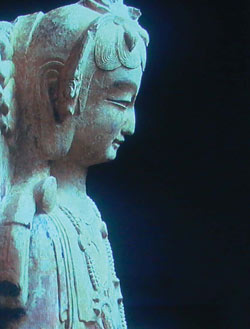| A Tale of Two Museums |
| http://www.sina.com.cn 2005/04/26 19:12 thats China |
Examining the efforts of the Shanghai Museum and Beijing's Millenium Art Museum By Kevin Holden
China's top art centers are now competing to rival those in Paris, Berlin or New York in attracting globally mobile art aficionados. The Millennium Art Museum (MAM) in Beijing is fast-forwarding into the digital future, while in the southeast, the Shanghai Museum is rewinding into China's imperial past. Visitors to MAM's new underground art center on western Beijing's Chang'an Avenue, might be startled the first time the framed "still-lifes" on display start magically moving, speaking, and even swapping positions with other artworks meters away. In some cases, the near-instantaneous exchange might involve works from museums that are continents away. These "moving pictures" are not an illusion, nor are they something out of Harry Potter books. They're part of the Millennium Art Museum's wide-ranging plan "to make art more accessible to the public, more interactive, and more universal in appeal," says Chaos Chen, one of the dynamic young curators behind the venue's transformation into a global art space. Part of the Millennium's new art center, the digital gallery resembles the web-wired art tableaux scattered through the hyper-hi-tech home of Microsoft founder Bill Gates. Giant plasma screens display impressionist images that morph into surrealist sculptures or futuristic films in an endlessly changing digital montage. The museum has also added a state-of-the-art theater and four smaller exhibition halls - all wired to the World Wide Web - to make the e-arts center the most advanced in China. The digital gallery's 20 computer-controlled screens, which form a vast ring around the core of the circular art center, were unveiled on January 1, featuring a collection of modern artworks from the Orsay Museum in Paris. Artworks on each screen are rotated every one to 10 minutes, so museumgoers can view up to 1200 works per hour across the framed displays, says MAM Vice Director Wang Yudong. In the future, the digital display space will showcase everything from "paintings to new media artworks from all over the world," he adds. Wang says the Orsay exhibition will be followed by a Pompidou Center show this spring that similarly circumvents the need to transport a traditional collection by displaying each work's digitally cloned twin. The Millennium's exhibits will increasingly focus on works in new media, which cover the spectrum of "digital videos, internet art/tech, digital photography, and other forms of digital imagery, including animations and virtual reality," says Wang.
The museum began etching out a place on the international art map with a 2002 exhibition titled "Salvador Dali - A Journey Into Fantasy," which was jointly staged with the Danish United Exhibits Group. Danish Ambassador Ole Lonsmann Poulsen called the surrealist show "a true European exhibition" embedded with "the newest interactive technologies developed in Denmark." The ambassador said the event was not only a showcase on Dali's life and art, but also "a journey into new ways of making museum exhibitions on art and culture." The first exhibition of Dali's dream-inspired artworks in China, with a multi-media set-up that encouraged fans to experiment with their own surrealist creations, drew countless youths who have grown up with satellite television, Sony play-stations, and Web cafes, and who might shy away from more conventional museum events. Curator Chen says that besides attracting spectators from every circle of China's increasingly diverse society, the museum aims "to keep the Chinese audience aware of the most extraordinary developments in art worldwide - the greatest achievements of humanity." Chen, who frequently shuttles between Beijing, Paris, Berlin and New York to keep up with art trends, says that during the close of the last century, "The Museum of Modern Art [in New York City] organized the best-ever symposium on how to make art more interactive and accessible, and that started a whole new discourse on modern art museums." The Museum of Modern Art (MoMA) has since started using the Web to reach out to the young and old, the city and the world. MoMA's website (www.moma.org/), for example, uses a green alien in a Macromedia Flash animation to attract youngsters. This cartoon extraterrestrial encourages kids not only to view paintings like Vincent van Gogh's Starry Night, but also to write poetry about the stars. They are invited to run their cursors along Umberto Boccioni's Unique Forms of Continuity in Space as the sculpture emits music ranging from techno to chill out to neo-classical.
|
| 【评论】【英语论坛】【大 中 小】【打印】【下载点点通】【多种方式看新闻】【收藏】【关闭】 |

